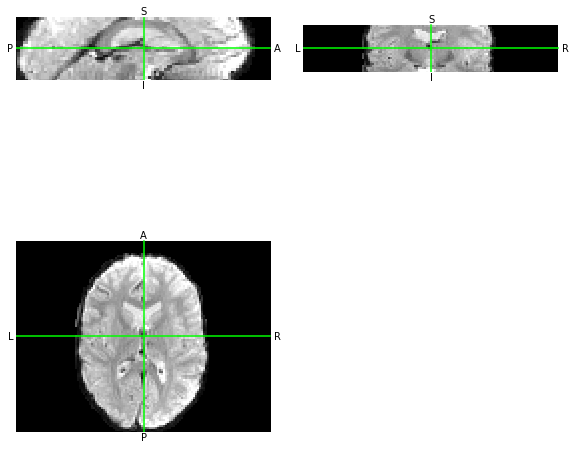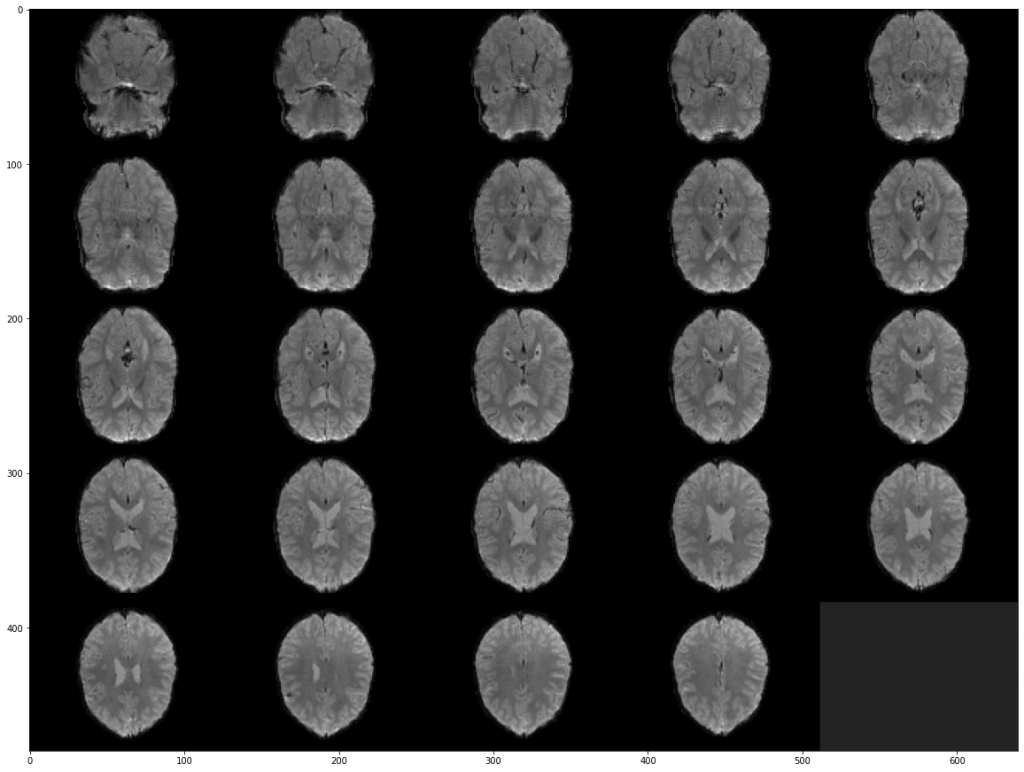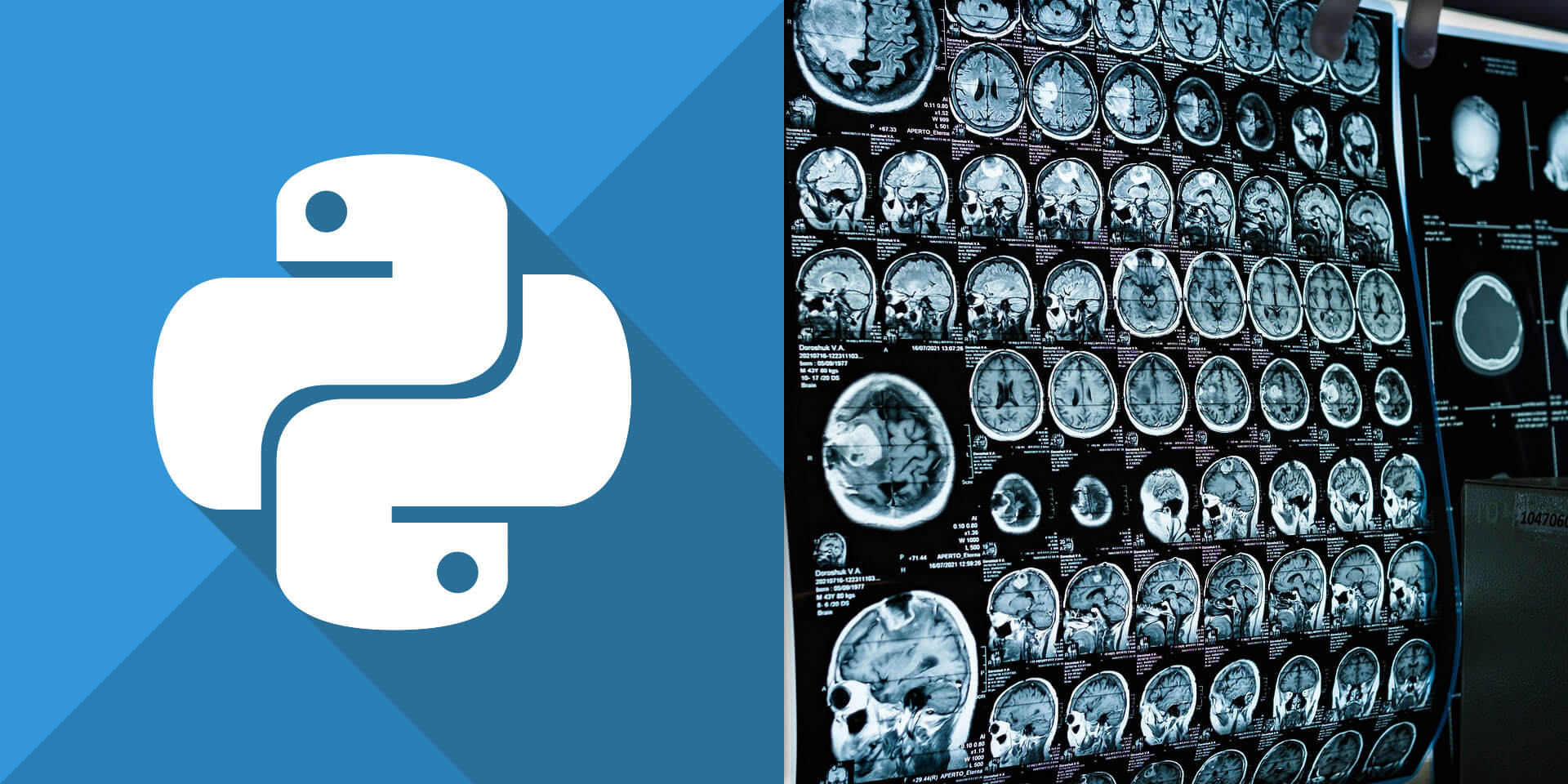本篇介紹如何在 Python 中使用 NiBabel 或 SimpleITK 模組讀取並顯示 NIfTI 影像(.nii、.nii.gz)。
NiBabel 是一個專門用於處理醫學與神經影像的模組,對於 NIfTI 影像格式支援度非常好,而 SimpleITK 則是通用型的影像處理模組,可以在讀取 NIfTI 影像之後,進行各種後續分析。這兩套工具都可以用來查看 NIfTI 影像,以下是操作教學。
NiBabel 模組
安裝 NiBabel
NiBabel 可以直接以 pip 安裝:
# 安裝 NiBabel 模組
pip install nibabel
讀取 NIfTI 影像
在 NiBabel 模組中附帶了一些範例影像檔,以下示範讀取 NIfTI 1 影像檔案的方式:
import os import nibabel as nib from nibabel.testing import data_path # 取得 NIfTI 1 範例影像路徑 example_ni1 = os.path.join(data_path, 'example4d.nii.gz') # 載入 NIfTI 1 範例影像 n1_img = nib.load(example_ni1)
NIfTI 1 的標頭長度為 352 位元組,包含以下欄位:
# 顯示 NIfTI 1 範例影像標頭資訊 print(n1_img.header)
<class 'nibabel.nifti1.Nifti1Header'> object, endian='<' sizeof_hdr : 348 data_type : b'' db_name : b'' extents : 0 session_error : 0 regular : b'r' dim_info : 57 dim : [ 4 128 96 24 2 1 1 1] intent_p1 : 0.0 intent_p2 : 0.0 intent_p3 : 0.0 intent_code : none datatype : int16 bitpix : 16 slice_start : 0 pixdim : [-1.000000e+00 2.000000e+00 2.000000e+00 2.199999e+00 2.000000e+03 1.000000e+00 1.000000e+00 1.000000e+00] vox_offset : 0.0 scl_slope : nan scl_inter : nan slice_end : 23 slice_code : unknown xyzt_units : 10 cal_max : 1162.0 cal_min : 0.0 slice_duration : 0.0 toffset : 0.0 glmax : 0 glmin : 0 descrip : b'FSL3.3\x00 v2.25 NIfTI-1 Single file format' aux_file : b'' qform_code : scanner sform_code : scanner quatern_b : -1.9451068e-26 quatern_c : -0.9967085 quatern_d : -0.08106874 qoffset_x : 117.8551 qoffset_y : -35.722942 qoffset_z : -7.2487984 srow_x : [-2.0000000e+00 6.7147157e-19 9.0810245e-18 1.1785510e+02] srow_y : [-6.7147157e-19 1.9737115e+00 -3.5552824e-01 -3.5722942e+01] srow_z : [ 8.2554809e-18 3.2320762e-01 2.1710818e+00 -7.2487984e+00] intent_name : b'' magic : b'n+1'
NIfTI 2 影像檔案的讀取方式也都相同:
# 取得 NIfTI 2 範例影像路徑 example_ni2 = os.path.join(data_path, 'example_nifti2.nii.gz') # 載入 NIfTI 2 範例影像 n2_img = nib.load(example_ni2)
NIfTI 2 的標頭長度為 540 位元組,但欄位數量較少:
# 顯示 NIfTI 2 範例影像標頭資訊 print(n2_img.header)
<class 'nibabel.nifti2.Nifti2Header'> object, endian='<' sizeof_hdr : 540 magic : b'n+2' eol_check : [13 10 26 10] datatype : int16 bitpix : 16 dim : [ 4 32 20 12 2 1 1 1] intent_p1 : 0.0 intent_p2 : 0.0 intent_p3 : 0.0 pixdim : [-1.00000000e+00 2.00000000e+00 2.00000000e+00 2.19999909e+00 2.00000000e+03 1.00000000e+00 1.00000000e+00 1.00000000e+00] vox_offset : 0 scl_slope : nan scl_inter : nan cal_max : 1162.0 cal_min : 0.0 slice_duration : 0.0 toffset : 0.0 slice_start : 0 slice_end : 23 descrip : b'FSL3.3\x00 v2.25 NIfTI-1 Single file format' aux_file : b'' qform_code : scanner sform_code : scanner quatern_b : -1.9451068140294884e-26 quatern_c : -0.9967085123062134 quatern_d : -0.0810687392950058 qoffset_x : 117.8551025390625 qoffset_y : -35.72294235229492 qoffset_z : -7.248798370361328 srow_x : [-2.00000000e+00 6.71471565e-19 9.08102451e-18 1.17855103e+02] srow_y : [-6.71471565e-19 1.97371149e+00 -3.55528235e-01 -3.57229424e+01] srow_z : [ 8.25548089e-18 3.23207617e-01 2.17108178e+00 -7.24879837e+00] slice_code : unknown xyzt_units : 10 intent_code : none intent_name : b'' dim_info : 57 unused_str : b''
顯示影像
顯示影像之前,先查看一下影像的大小:
# 查看影像尺寸 print(n1_img.dataobj.shape)
(128, 96, 24, 2)
若要顯示 3D 影像各軸的切面,可以使用 OrthoSlicer3D:
from nibabel.viewers import OrthoSlicer3D # 建立 OrthoSlicer3D Viewer 物件 osViewer = OrthoSlicer3D(n1_img.dataobj[:,:,:,0]) # 設定三軸的切面位置 osViewer.set_position(64, 48, 12) # 顯示三軸切面 osViewer.show()

另一種方式是使用 matplotlib 來繪製切面圖,效果都差不多:
import matplotlib.pyplot as plt # 繪製多張切面圖 def show_slices(slices): fig, axes = plt.subplots(1, len(slices)) for i, slice in enumerate(slices): axes[i].imshow(slice.T, cmap="gray", origin="lower") # 建立各軸切面 slice0 = n1_img.dataobj[64, :, :, 0] slice1 = n1_img.dataobj[:, 48, :, 0] slice2 = n1_img.dataobj[:, :, 12, 0] # 顯示各軸切面 show_slices([slice0, slice1, slice2])

SimpleITK
安裝 SimpleITK
SimpleITK 可以直接以 pip 安裝:
# 安裝 SimpleITK 模組
pip install SimpleITK
讀取 NIfTI 影像
SimpleITK 可以使用其 ReadImage 直接讀取 NIfTI 影像,這裡我們沿用上面 NiBabel 模組的 NIfTI 範例影像:
import SimpleITK as sitk # 使用 SimpleITK 讀取 n1_img2 = sitk.ReadImage(example_ni1) # 轉為 NumPy 陣列 n1_img_arr = sitk.GetArrayFromImage(n1_img2) # 查看影像尺寸 print(n1_img_arr.shape)
(128, 96, 24, 2)
使用 SimpleITK 讀取出來的影像維度排列順序跟 NiBabel 不同,在處理上要注意。
顯示所有切面
我們可以使用 scikit-image 的 montage 將 3D 影像的每個切面抽出來,拼成一大張影像。使用前要先安裝 scikit-image 模組:
# 安裝 scikit-image 模組
pip install scikit-image
以下是顯示 3D 影像所有切面的範例:
from skimage.util import montage # 顯示所有切面 fig, ax = plt.subplots(1, 1, figsize = (20, 20)) ax.imshow(montage(n1_img_arr[0]), cmap ='gray')


